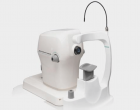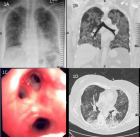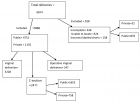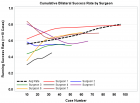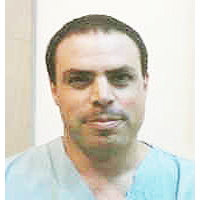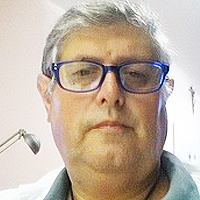Abstract
Review Article
Primary Cutaneous Lymphomas and Interferon Treatment
Ajda ERSOY GUNES, Melda COMERT OZKAN*, Fahri SAHIN and Guray SAYDAM
Published: 09 January, 2017 | Volume 1 - Issue 1 | Pages: 001-010
Primary cutaneous lymphomas (PCLs) are the second most common group of extranodal non-Hodgkin lymphomas (NHL) with an estimated annual incidence of 1/100.000. Interferons (IFNs) are used in mono or combination therapy for cutaneous lymphomas especially for cutaneous T-cell lymphomas (CTCL) for years. IFN-α is the most widely-used type for cutaneous lymphomas. IFN-α has been shown to be a highly active agent in CTCL with response rates ranging from 40% to 80%. In this review, the current information about PCLs and IFNs treatment is summarized.
Read Full Article HTML DOI: 10.29328/journal.jhcr.1001001 Cite this Article Read Full Article PDF
References
- Willemze R, Dreyling M. Primary cutaneous lymphomas: ESMO Clinical Practice Guidelines for diagnosis, treatment and follow-up. Ann Oncol. 2010; 5: 177-180. Ref.: https://goo.gl/GOeMgn
- Willemze R, Jaffe ES, Burg G, Cerroni L, Berti E, et al. WHO-EORTC classification for cutaneous lymphomas. Blood. 2005; 105: 3768-3785. Ref.: https://goo.gl/P3lMnA
- Khader A, Manakkad SP, Shaan M, Sarita Sasidharan Pillai, Najeeba Riyaz, et al. A Clinicopathological Analysis of Primary Cutaneous Lymphomas: A 6-year Observational Study at a Tertiary Care Center of South India. Indian J Dermatol. 2016; 61: 608-617. Ref.: https://goo.gl/Yl1QdG
- Cerroni L.. Past, present and future of cutaneous lymphomas. Semin Diagn Pathol. 2016; S0740-2570: 30091-30100. Ref.: https://goo.gl/8QyO76
- Criscione VD, Weinstock MA. Incidence of cutaneous T-cell lymphoma in the United States, 1973-2002. Arch Dermatol. 2007; 143: 854-859. Ref.: https://goo.gl/gPa2op
- Kim YH, Liu HL, Mraz-Gernhard S, Varghese A, Hoppe RT. Long-term outcome of 525 patients with mycosis fungoides and Sezary syndrome: clinical prognostic factors and risk for disease progression. Arch Dermatol. 2003; 139: 857-866. Ref.: https://goo.gl/2wkmIr
- Wain EM, Orchard GE, Whittaker SJ, Spittle MF, Russell-Jones R. Outcome in 34 patients with juvenile-onset mycosis fungoides: a clinical, immunophenotypic, and molecular study. Cancer. 2003; 98: 2282-2290. Ref.: https://goo.gl/PKHTQY
- Shohat M, Hodak E, Hannig H, Bodemer W, David M, et al. Evidence for the cofactor role of human T-cell lymphotropic virüs type 1in mycosis fungoides and Sezary syndrome. Br J Dermatol. 1999; 141: 44-49. Ref.: https://goo.gl/TIupYh
- Chong BF, Wilson AJ, Gibson HM, Hafner MS, Luo Y, et al. Immune function abnormalities in peripheral blood mononuclear cell cytokine expression differentiates stages of cutaneous T-cell lymphoma/mycosis fungoides. Clin Cancer Res. 2008; 14: 646-653. Ref.: https://goo.gl/YFxt5v
- Olsen E, Whittaker S, Kim Y, Duvic M, Prince HM, et al. Clinical end points and response criteria in mycosis fungoides and Sézary syndrome: a consensus statement of the International Society for Cutaneous Lymphoma, the United States Cutaneous Lymphoma Consortium, and the Cutaneous Lymphoma Task Force of the European Organisation for Research and Treatment of Cancer. J Clin Oncol 2011; 29: 2598-2607. Ref.: https://goo.gl/w1IKQA
- Horwitz SM, Olsen EA, Duvic M, Porcu P, Kim YH. Review of the treatment of mycosis fungoides and Sézary syndrome: a stage based approach. J Natl Compr Canc Netw. 2008; 6: 436-442. Ref.: https://goo.gl/fW026Z
- Guarino MF, Olasolo J. Photodynamic Therapy for Mycosis Fungoides. Actas Dermosifiliogr. 2013; 104: 393-399. Ref.: https://goo.gl/dAldUU
- Wieselthier JS, Koh HK. Sézary syndrome: diagnosis, prognosis, and critical review of treatment options. J Am Acad Dermatol. 1990; 22: 381-401. Ref.: https://goo.gl/vWSrk3
- Sugaya M, Hamada T, Kawai K, Yonekura K, Ohtsuka M, et al. Guidelines for the management of cutaneous lymphomas (2011): A consensus statement by the Japanese Skin Cüancer Society - Lymphoma Study Group. J Dermatol. 2013; 40: 2-14. Ref.: https://goo.gl/h09LQU
- Yamada Y, Tomonaga M. The current status of therapy for adult T-cell leukaemia-lymphoma in Japan. Leuk Lymphoma. 2003; 44: 611-618. Ref.: https://goo.gl/Mt66w7
- Takahashi K, Tanaka T, Fujita M, Horiguchi Y, Miyachi Y, et al. Cutaneous-type adult T-cell leukemia/lymphoma. A unique clinical feature with monoclonal T-cell proliferation detected by Southern blot analysis. Arch Dermatol. 1988; 124: 399-404. Ref.: https://goo.gl/09v8nG
- Camp B, Horwitz S, Pulitzer MP. Adult T-cell leukemia/lymphoma with follicular mucinosis: an unusual histopathological finding and a commentary. J Cutan Pathol. 2012; 39: 861-865. Ref.: https://goo.gl/3RQX66
- Marçais A, Suarez F, Sibon D, Bazarbachi A, Hermine O. Clinical trials of adult T-cell leukaemia/lymphoma treatment. Leuk Res Treatment. 2012. Ref.: https://goo.gl/Rfn1es
- Sawada Y, Hino R, Hama K, Ohmori S, Fueki H, et al. Type of skin eruption is an independent prognostic indicator for adult T-cell leukemia/lymphoma. Blood. 2011; 117: 3961-3967. Ref.: https://goo.gl/RcWRWj
- Nicot C. Current views in HTLV-I-associated adult T-cell leukemia/lymphoma. Am J Hematol. 2005; 78: 232-239. Ref.: https://goo.gl/QYsTcW
- Oliveira PD, Farre L, Bittencourt AL. Adult T-cell leukemia/lymphoma. Rev Assoc Med Bras (1992). 2016; 62: 691-700. Ref.: https://goo.gl/PG4op5
- Whittaker SJ, Mackie RM. Cutaneous lymphoma and lymphocytic infiltrates. In: Burns. T, Breathnach S, Cox N, Griffith C, editors. Rook's textbook of dermatology. Italy: Blackwell Science Ltd; 2004; 54.1-54.53. Ref.: https://goo.gl/gDAOeL
- Biswas A, Gey van Pittius D, Stephens M, Smith AG. Reccurent primary cutaneous lymphoma with florid pseudoepitheliomatous hyperplasia masquerading as squamous cell carcinoma. Histopathology. 2008; 52: 755-758. Ref.: https://goo.gl/BIL8s1
- Singh S, Gupta N, Tekta GR. Imprint cytology facilitating the diagnosis of primary cutaneous anaplastic large cell lymphoma of iliac fossa. J Cytol. 2012; 29: 267-269. Ref.: https://goo.gl/wkHmZU
- Desai A, Telang GH, Olszewski AJ. Remission of primary cutaneous anaplastic large cell lymphoma after a brief course of brentuximab vedotin. Ann Hematol. 2013; 92: 567-568. Ref.: https://goo.gl/3s6FqN
- Brice P, Cazals D, Mounier N, Verola O, Neidhart-Berard AM, et al. Primary cutaneous large-cell lymphoma: analysis of 49 patients included in the LNH87 prospective trial of polychemotherapy for high-grade lymphomas. Groupe d'Etude des Lymphomes de l'Adulte. Leukemia. 1998; 12: 213-219. Ref.: https://goo.gl/cDJl4L
- Kempf W, Pfaltz K, Vermeer MH, Cozzio A, Ortiz-Romero PL, et al. EORTC, ISCL, and USCLC consensus recommendations for the treatment of primary cutaneous CD30-positive lymphoproliferative disorders: lymphomatoid papulosis and primary cutaneous anaplastic large-cell lymphoma. Blood. 2011; 118: 4024-4035. Ref.: https://goo.gl/e7SKZn
- Magorien J, Hillman JD, Pinter-Brown LC, Said J, Chiu MW. Acral lymphomatoid papulosis associated with poikilodermatous mycosis fungoides. Dermatol Online J. 2013; 19: 1. Ref.: https://goo.gl/z5rIFM
- Zackheim HS, Jones C, Leboit PE, Kashani-Sabet M, McCalmont TH, et al. Lymphomatoid papulosis associated with mycosis fungoides: a study of 21 patients including analyses for clonality. J Am AcadDermatol. 2003; 49: 620-623. Ref.: https://goo.gl/zlqMbP
- Dasanu CA, Gopal S, Davis LK, Atienza JA. Letter to the editor: Subcutaneous panniculitis-like T-cell lymphoma in a patient with history of B-cell lymphoma treated successfully with chemotherapy 15 years prior. Journal of Oncology Pharmacy Practice. 2013; 3: 1-3. Ref.: https://goo.gl/IdB5oc
- Takada H, Ohga S, Mizuno Y, Suminoe A, Matsuzaki A, et al. Oversecretion of IL-18 in haemophagocytic lymphohistiocytosis: a novel marker of disease activity. Br J Haematol. 1999; 106: 182-189. Ref.: https://goo.gl/7Rk3Sj
- Willemze R, Jansen PM, Cerroni L, Berti E, Santucci M, et al. Subcutaneous panniculitis-like T-cell lymphoma: definition, classification, and prognostic factors: an EORTC Cutaneous Lymphoma Group Study of 83 cases. Blood. 2008; 111: 838-845. Ref.: https://goo.gl/ISngr0
- Go RS, Wester SM. Immunophenotypic and molecular features, clinical outcomes, treatments, and prognostic factors associated with subcutaneous panniculitis-like T-cell lymphoma: a systematic analysis of 156 patients reported in the literature. Cancer. 2004; 101: 1404-1413. Ref.: https://goo.gl/t2Sy46
- Li YJ, Li ZM, Xia Y, Huang JJ, Huang HQ, et al. Serum C-Reactive Protein (CRP) as a Simple and Independent Prognostic Factor in Extranodal Natural Killer/T-Cell Lymphoma, Nasal Type. PLoS One. 2013; 8: e64158. Ref.: https://goo.gl/oNQEPc
- Suzuki R, Suzumiya J, Yamaguchi M, Nakamura S, Kameoka J, et al. Prognostic factors for mature natural killer (NK) cell neoplasms: aggressive NK cell leukemia and extranodal NK cell lymphoma, nasal type. Ann Oncol. 2010; 21: 1032-1040. Ref.: https://goo.gl/iFQWVh
- Huang JJ, Jiang WQ, Lin TY, Huang Y, Xu RH, et al. Absolute lymphocyte count is a novel prognostic indicator in extranodal natural killer/T-cell lymphoma, nasal type. Ann Oncol. 2011; 22: 149-155. Ref.: https://goo.gl/Yq0ux8
- Wang L, Xia ZJ, Huang HQ, Lu Y, Zhang YJ. Cyclophosphamide, doxorubicin, vincristine, and prednisone (CHOP) in the treatment of stage IE/IIE extranodal natural killer/T cell lymphoma, nasal type: 13-year follow-up in 135 patients. Int J Hematol. 2012; 96: 617-623. Ref.: https://goo.gl/clLN5q
- Wang L, Wang Z, Chen X, Li Y, Wang K, et al. First-line combination of gemcitabine, oxaliplatin, and L-asparaginase (GELOX) followed by involved-field radiation therapy for patients with stage IE/IIE extranodal natural killer/T-cell lymphoma. Cancer. 2013; 119: 348-355. Ref.: https://goo.gl/tQsVFS
- Kempf W, Rozati S, Kerl K, French LE, Dummer R. Cutaneous peripheral T-cell lymphomas, unspecified/NOS and rare subtypes: a heterogeneous group of challenging cutaneous lymphomas. G Ital Dermatol Venereol. 2012; 147: 553-562. Ref.: https://goo.gl/PexpGi
- Kelly C, Klenerman P, Barnes E. Interferon lambdas: the next cytokine storm. Gut. 2011: 60; 1284-1293. Ref.: https://goo.gl/FW6H9N
- Bunn PA Jr, Ihde DC, Foon KA. The role of recombinant interferon alfa-2a in the therapy of cutaneous T-cell lymphomas. Cancer. 1986; 57: 1689-1695. Ref.: https://goo.gl/se87HG
- Olsen EA, Bunn PA. Interferon in the treatment of cutaneous T-cell lymphoma. Hematol Oncol Clin North Am. 1995; 9: 1089-1107. Ref.: https://goo.gl/Vp8QuD
- Bunn PA Jr, Hoffman SJ, Norris D, Golitz LE, Aeling JL. Systemic therapy of cutaneous T-cell lymphomas (mycosis fungoides and the Sezary syndrome). Ann Intern Med. 1994; 121: 592-602. Ref.: https://goo.gl/U2pWkl
- Quintas-Cardama A, Kantarjian H, Manshouri T, Luthra R, Estrov Z, et al. Pegylated interferon alfa-2a yields high rates of hematologic and molecular response in patients with advanced essential thrombocythemia and polycythemia vera. J Clin Oncol. 2009; 27: 5418-5424. Ref.: https://goo.gl/MzQeY0
- Bottomley A, Coens C, Suciu S, Santinami M, Kruit W, et al. Adjuvant therapy with pegylated interferon alfa-2b versus observation in resected stage III melanoma: a phase III randomized controlled trial of health-related quality of life and symptoms by the European Organisation for Research and Treatment of Cancer Melanoma Group. J Clin Oncol. 2009; 27: 2916-2923. Ref.: https://goo.gl/kQoqiS
- Feldman DR, Kondagunta GV, Schwartz L, Patil S, Ishill N, et al. Phase II trial of pegylated interferon-alpha 2b in patients with advanced renal cell carcinoma.Clin Genitourin Cancer. 2008; 6: 25-30. Ref.: https://goo.gl/6hQBVc
- Bukowski R, Ernstoff MS, Gore ME, Nemunaitis JJ, Amato R, et al. Pegylated interferon alfa-2b treatment for patients with solid tumors: a phase I ⁄ II study. J Clin Oncol. 2002; 20: 3841-3849. Ref.: https://goo.gl/L9gP7C
- Itoh Y, Okanoue T, Enjyo F, Morimoto M, Takeuchi T, et al. Elevated interleukin-6 and gamma-globulin during interferon therapy of hepatitis B. Am J Gastroenterol. 1992; 87: 1485-1487. Ref.: https://goo.gl/Vllfgy
- Sacchi S, Kantarjian H, O'Brien S, Cohen PR, Pierce S, et al. Immune-mediated and unusual complications during interferon alfa therapy in chronic myelogenous leukemia. J Clin Oncol. 1995; 13: 2401-2407. Ref.: https://goo.gl/8qFG1E
- Bunn PA Jr, Foon KA, Ihde DC, Longo DL, Eddy J, et al. Recombinant leukocyte A interferon: an active agent in advanced cutaneous T-cell lymphomas. Ann Intern Med. 1984; 101: 484-487. Ref.: https://goo.gl/xSpXeQ
- Ross C, Tingsgaard P, Jorgensen H, Vejlsgaard GL. Interferon treatment of cutaneous T-cell lymphoma. Eur J Haematol. 1993; 51: 63-72. Ref.: https://goo.gl/VjYKUv
- Mostow EN, Neckel SL, Oberhelman L, Anderson TF, Cooper KD. Complete remissions in- psoralen and UV-A (PUVA)-refractory mycosis fungoides-type cutaneousT-cell lymphoma with combined interferon alfa and PUVA. Arch Dermatol. 1993; 129: 747-752. Ref.: https://goo.gl/rpkuD8
- Rupoli S, Barulli S, Guiducci B, Offidani M, Mozzicafreddo G, et al. Low dose interferon-alpha2b combined with PUVA is an effective treatment of early stage mycosis fungoides: results of a multicenter study. Cutaneous-T Cell Lymphoma Multicenter Study Group. Haematologica. 1999; 84: 809-813. Ref.: https://goo.gl/1n56s0
- Rupoli S, Goteri G, Pulini S, Filosa A, Tassetti A, et al. Long-term experience with low-dose interferon-alpha and PUVA in the management of early mycosis fungoides. Eur J Haematol. 2005; 75: 136-145. Ref.: https://goo.gl/G8VbPN
- Knobler RM, Trautinger F, Radaszkiewicz T, Kokoschka EM, Micksche M. Treatment of cutaneous T cell lymphoma with a combination of low-dose interferon alfa-2b and retinoids. J Am Acad Dermatol. 1991; 24: 247-252. Ref.: https://goo.gl/9fG9LS
- Straus DJ, Duvic M, Kuzel T, Horwitz S, Demierre MF, et al. Results of a phase II trial of oral bexarotene (Targretin) combined with interferon alfa-2b (Intron-A for patients with cutaneous T-cell lymphoma. Cancer. 2007; 109: 1799-1803. Ref.: https://goo.gl/8k77Zz
- Hüsken AC, Tsianakas A, Hensen P, Nashan D, Loquai C, et al. Comparison of pegylated interferon α-2b plus psoralen PUVA versus standard interferon α-2a plus PUVA in patients with cutaneous T-cell lymphoma. J Eur Acad Dermatol Venereol. 2012; 26: 71-78. Ref.: https://goo.gl/iyuuyK
- Zinzani PL, Mazza P, Gherlinzoni F. Beta interferon in the treatment of mycosis fungoides. Haematologica. 1988; 73: 547-548. Ref.: https://goo.gl/itFFrc
- Kaplan EH, Rosen ST, Norris DB, Roenigk HH Jr, Saks SR, et al. Phase II study of recombinant human interferon gamma for treatment of cutaneous T-cell lymphoma. J Natl Cancer Inst. 1990; 82: 208-212. Ref.: https://goo.gl/35FjIl
- Jimbow K, Yamana K, Ishida O, Kawamura M, Ito Y, et al. Evaluation of rIFN-gamma in the treatment of lymphoma and melanoma of the skin by systemic and intralesional administration. Gan To Kagaku Ryoho. 1987; 14: 152-158. Ref.: https://goo.gl/Kaf9ab
- Cozzio A, Kempf W, Schmid-Meyer R, Gilliet M, Michaelis S, et al. Intra-lesional low-dose interferon alpha 2a therapy for primary cutaneous marginal zone B-cell lymphoma. Leuk Lymphoma. 2006; 47: 865-869. Ref.: https://goo.gl/m9W0Pa
- Kutting B, Bonsmann G, Metze D, Luger TA, Cerroni L. Borrelia burgdorferi-associated primary cutaneous B cell lymphoma: complete clearing of skin lesions after antibiotic pulse therapy or intralesional injection of interferon alfa-2a. J Am Acad Dermatol. 1997; 36: 311-314. Ref.: https://goo.gl/iDdZNW
- Parodi A, Micalizzi C, Rebora A. Intralesional natural interferon alpha in the treatment of Crosti's lymphoma (primary cutaneous B follicular centre-cell lymphoma): report of four cases. J Dermatol Treatment. 1996; 7: 105-107. Ref.: https://goo.gl/dBcl45
- Zenone T, Catimel G, Barbet N, Clavel M. Complete remission of a primary cutaneous B cell lymphoma treated with intralesional recombinant interferon alpha-2a. Eur J Cancer. 1994; 30: 246-247. Ref.: https://goo.gl/NgPT4z
Similar Articles
-
Primary Cutaneous Lymphomas and Interferon TreatmentAjda ERSOY GUNES,Melda COMERT OZKAN*,Fahri SAHIN,Guray SAYDAM. Primary Cutaneous Lymphomas and Interferon Treatment. . 2017 doi: 10.29328/journal.jhcr.1001001; 1: 001-010
-
Neutrophil to Lymphocyte Ratio (NLR) in Peripheral Blood: A Novel and Simple Prognostic Predictor of Non-small Cell Lung Cancer (NSCLC)Xiaoli Zhang,Ziyuan Zou,Liyu Fan,Xinjie Xu,Yu Siyuan,Peng Luo*. Neutrophil to Lymphocyte Ratio (NLR) in Peripheral Blood: A Novel and Simple Prognostic Predictor of Non-small Cell Lung Cancer (NSCLC). . 2017 doi: 10.29328/journal.jhcr.1001002; 1: 011-013
-
Cytomegalovirus pneumonia and Cryptogenic organizing pneumonia following pediatric stem cell transplantation for leukemiaZühre Kaya*,Tuba Şişmanlar,Ayşe Tana Aslan,Öznur Konuş Boyunağa,Işıl Fidan Balcı,İdil Yenicesu,Ülker Koçak. Cytomegalovirus pneumonia and Cryptogenic organizing pneumonia following pediatric stem cell transplantation for leukemia. . 2017 doi: 10.29328/journal.jhcr.1001003; 1: 014-018
-
Preservation of Haemostasis with Anti-thrombotic Serotonin AntagonismMark IM Noble*,Angela J Drake-Holland. Preservation of Haemostasis with Anti-thrombotic Serotonin Antagonism. . 2017 doi: 10.29328/journal.jhcr.1001004; 1: 019-025
-
Status of protection against Hepatitis B infection among healthcare workers (HCW) in a tertiary healthcare center in India: results can’t be ignored!Pandey Prashant,Agarwal Nitin*,Das Suryasanta,Dharmendra Kumar. Status of protection against Hepatitis B infection among healthcare workers (HCW) in a tertiary healthcare center in India: results can’t be ignored!. . 2018 doi: 10.29328/journal.jhcr.1001005; 2: 001-005
-
Evaluation of the effects of Leech Salivary Extract (LSE) on Haematological parameters in RatsHausatu Babayi*,Ojo Olufunmilola Praise,Labake Fadipe Ajoke,Israel Kayode Olayemi,Elisha Baba,Oladosun Oluwale Peter. Evaluation of the effects of Leech Salivary Extract (LSE) on Haematological parameters in Rats. . 2018 doi: 10.29328/journal.jhcr.1001006; 2: 006-014
-
Successful management of disseminated Fusarium infection in a patient with acute myeloid leukemiaAlShammasi S,AlNujaidi D,Bakhit K,Algarni A,AlAnazi KA*. Successful management of disseminated Fusarium infection in a patient with acute myeloid leukemia. . 2018 doi: 10.29328/journal.jhcr.1001007; 2: 015-020
-
Reversal of pure red cell aplasia by varicella zoster virus infectionAl-Anazi KA*,Kanfar S,Aldayel A,Abduljalil O,Sayyed AH. Reversal of pure red cell aplasia by varicella zoster virus infection. . 2019 doi: 10.29328/journal.jhcr.1001008; 3: 001-010
-
Varicella zoster virus: The potentially useful virusAl-Anazi KA*,Al-Jasser AM. Varicella zoster virus: The potentially useful virus. . 2019 doi: 10.29328/journal.jhcr.1001009; 3: 011-015
-
The beneficial effects of varicella zoster virusKhalid Ahmed Al-Anazi*,Al-Anazi WK,Al-Jasser AM. The beneficial effects of varicella zoster virus. . 2019 doi: 10.29328/journal.jhcr.1001010; 3: 016-049
Recently Viewed
-
The role of denial on emotional correlates of childhood trauma in a non-clinical populationSanja Krvavac*,Billy Jansson. The role of denial on emotional correlates of childhood trauma in a non-clinical population. Arch Psychiatr Ment Health. 2022: doi: 10.29328/journal.apmh.1001043; 6: 040-047
-
Role of toll-like receptors and their ligands in adipocyte secretionA Mishra*,AV Shestopalov,AM Gaponov,IA Alexandrov,SA Roumiantsev. Role of toll-like receptors and their ligands in adipocyte secretion. Ann Proteom Bioinform. 2021: doi: 10.29328/journal.apb.1001012; 5: 001-007
-
Pigeonpea sterility mosaic virus a green plague-Current status of available drug and new potential targetsNisha Singh*,Bhawna Narula,Megha Ujinwal,Sapna Langyan. Pigeonpea sterility mosaic virus a green plague-Current status of available drug and new potential targets. Ann Proteom Bioinform. 2021: doi: 10.29328/journal.apb.1001013; 5: 008-026
-
The SARS CoV-2 spike domain, RGD and integrin binding effect-relationship for vaccine design strategyLuisetto M*,Tarro G,Khaled Edbey,Almukthar N,Cabianca L,Mashori GR,Yesvi AR,Latyschev OY. The SARS CoV-2 spike domain, RGD and integrin binding effect-relationship for vaccine design strategy. Ann Proteom Bioinform. 2021: doi: 10.29328/journal.apb.1001014; 5: 027-041
-
The dermatologic manifestations of COVID-19: a mini-reviewSabah Alharazy*. The dermatologic manifestations of COVID-19: a mini-review. Ann Proteom Bioinform. 2021: doi: 10.29328/journal.apb.1001015; 5: 042-048
Most Viewed
-
Feasibility study of magnetic sensing for detecting single-neuron action potentialsDenis Tonini,Kai Wu,Renata Saha,Jian-Ping Wang*. Feasibility study of magnetic sensing for detecting single-neuron action potentials. Ann Biomed Sci Eng. 2022 doi: 10.29328/journal.abse.1001018; 6: 019-029
-
Evaluation of In vitro and Ex vivo Models for Studying the Effectiveness of Vaginal Drug Systems in Controlling Microbe Infections: A Systematic ReviewMohammad Hossein Karami*, Majid Abdouss*, Mandana Karami. Evaluation of In vitro and Ex vivo Models for Studying the Effectiveness of Vaginal Drug Systems in Controlling Microbe Infections: A Systematic Review. Clin J Obstet Gynecol. 2023 doi: 10.29328/journal.cjog.1001151; 6: 201-215
-
Causal Link between Human Blood Metabolites and Asthma: An Investigation Using Mendelian RandomizationYong-Qing Zhu, Xiao-Yan Meng, Jing-Hua Yang*. Causal Link between Human Blood Metabolites and Asthma: An Investigation Using Mendelian Randomization. Arch Asthma Allergy Immunol. 2023 doi: 10.29328/journal.aaai.1001032; 7: 012-022
-
Impact of Latex Sensitization on Asthma and Rhinitis Progression: A Study at Abidjan-Cocody University Hospital - Côte d’Ivoire (Progression of Asthma and Rhinitis related to Latex Sensitization)Dasse Sery Romuald*, KL Siransy, N Koffi, RO Yeboah, EK Nguessan, HA Adou, VP Goran-Kouacou, AU Assi, JY Seri, S Moussa, D Oura, CL Memel, H Koya, E Atoukoula. Impact of Latex Sensitization on Asthma and Rhinitis Progression: A Study at Abidjan-Cocody University Hospital - Côte d’Ivoire (Progression of Asthma and Rhinitis related to Latex Sensitization). Arch Asthma Allergy Immunol. 2024 doi: 10.29328/journal.aaai.1001035; 8: 007-012
-
An algorithm to safely manage oral food challenge in an office-based setting for children with multiple food allergiesNathalie Cottel,Aïcha Dieme,Véronique Orcel,Yannick Chantran,Mélisande Bourgoin-Heck,Jocelyne Just. An algorithm to safely manage oral food challenge in an office-based setting for children with multiple food allergies. Arch Asthma Allergy Immunol. 2021 doi: 10.29328/journal.aaai.1001027; 5: 030-037

If you are already a member of our network and need to keep track of any developments regarding a question you have already submitted, click "take me to my Query."







